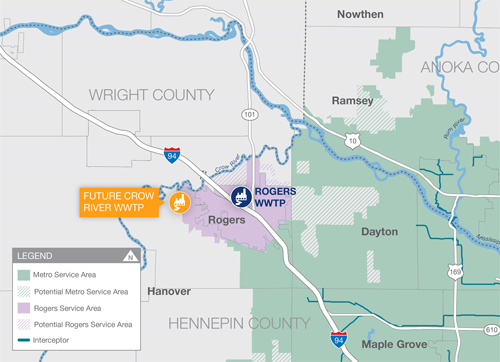Planning for replacement plant begins in 2020
In February, the Metropolitan Council authorized acquisition of the Rogers Wastewater Treatment Plant. The Council plans to operate the Rogers plant for about 10 years, then decommission the facility after a new Crow River Plant is built in western Hennepin County.
Estimated costs of acquiring and operating existing Rogers plant
Capital costs
Acquisition: $800,000
Needed capital improvements: $1.5M to 2.5M
Operations
Estimated annual operation/maintenance: $750,000
Estimated annual revenue from local user fees: $1.178M
Initially, the new Crow River plant will have the capacity to treat about three million gallons of wastewater a day, serving Rogers and portions of the cities of Corcoran and Dayton. Eventually, the plant could be expanded to treat up to six million gallons a day to accommodate growth in the northwest metro.
“The City of Rogers has operated its own wastewater treatment facility for decades,” said Leisa Thompson, general manager of the Council’s Environmental Services Division. “The transition to a new plant will address several key issues related to capacity.”
According to Thompson, planned growth in the northwest metro will use up the remaining reserve capacity of the existing treatment plant in Rogers over the next decade. The proposed replacement plant will serve anticipated growth, while also helping to preserve capacity in interceptors downstream that serve growth in the urban center.
Council officials say the acquisition of the Rogers Wastewater Treatment Plant will have a negligible impact on fees to local wastewater customers.
Upcoming project milestones
| Milestone |
Date |
| Execute acquisition agreement |
June 2019 |
| Transition Rogers Plant operations to Council |
Dec. 2019 |
| Begin planning Crow River Plant |
2020 |
| Begin Crow River Plant operations |
2030 |
| Decommission Rogers Plant |
2031 |
 The planned location of the Crow River Plant is on about 100 acres the Council purchased in 2016, south of I-94 at the intersection of Territorial Road and 141st Street.
The planned location of the Crow River Plant is on about 100 acres the Council purchased in 2016, south of I-94 at the intersection of Territorial Road and 141st Street.
Transition planning between the Council and City of Rogers dates back to the early 2000s. In October 2018, the city formally asked the Council to acquire the 60-year-old plant, citing needed capacity to meet growth expectations and needed investment in the plant to meet regulatory requirements.
“Discussions with the City of Rogers have been underway for more than 10 years,” said Jeannine Clancy, an assistant general manager in the Council’s Environmental Services Division. “Through the comprehensive planning process, the City of Rogers and the Council have planned for regional growth and the efficient use of infrastructure to support that growth.”
The regional wastewater treatment system is key to facilitating growth in the metro area. The system also helps to improve water quality in area lakes and rivers while protecting public health. Clancy calls it a successful regional/local collaboration and partnership that has spanned decades.
Regional system treats water from showers, sinks, toilets, washing machines...
The regional system currently serves 109 metro-area communities and 2.6 million residents, who benefit significantly from the cost advantages that result from the size and scale of the operation.
The regional system collects and treats about 250 million gallons of wastewater a day. Wastewater is conveyed to the regional system of pipes and plants via about 5,000 miles of sewers that local communities own and maintain.
Council officials estimate the value of the region’s investment in wastewater treatment infrastructure at $7 billion. That currently includes 8 treatment plants, 600 miles of interceptor pipe, and metering and lift stations to convey wastewater flow.